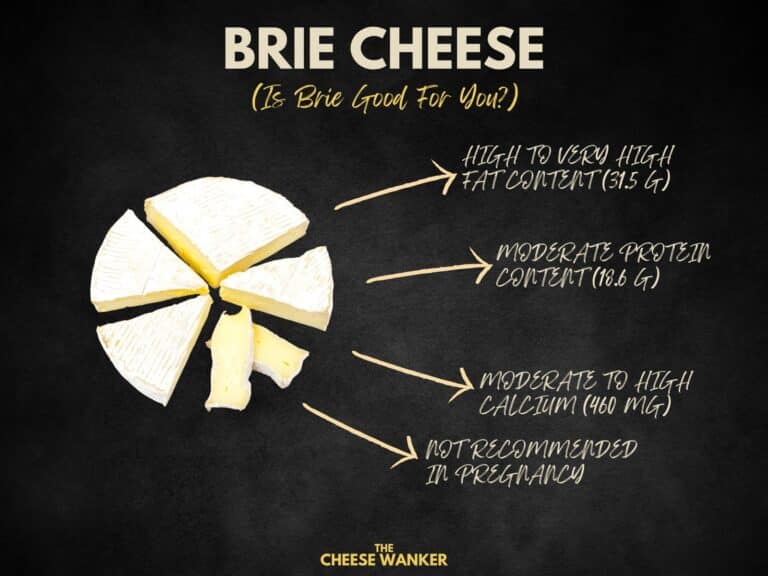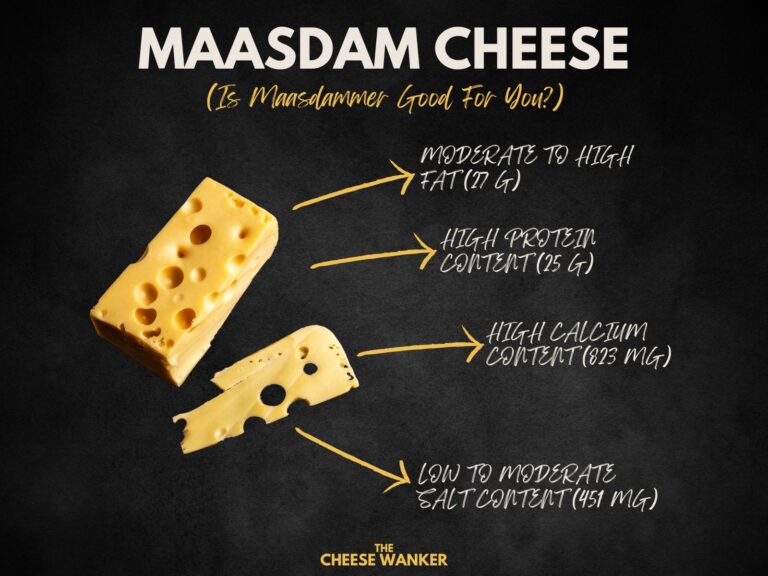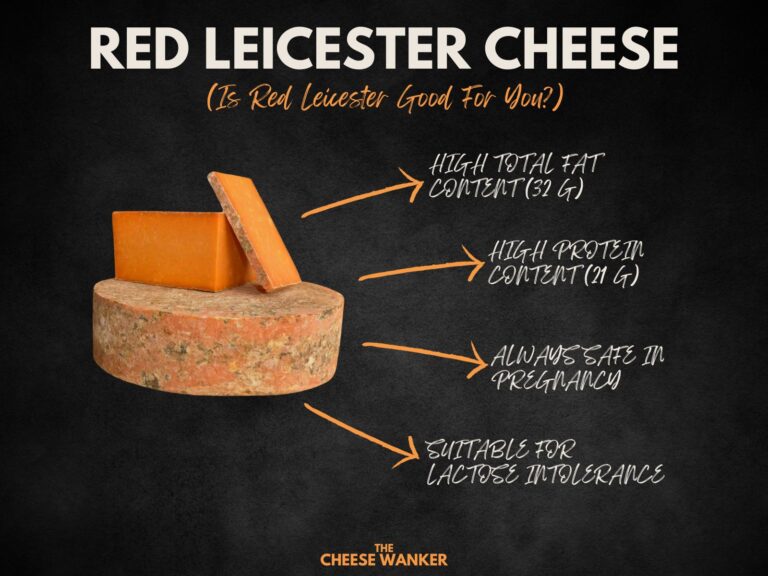Halloumi (also known as Haloumi) is an unripened brined cheese that originates from Cyprus. It has become hugely popular worldwide thanks to its high melting point and elastic texture. Yet, beyond its culinary allure, Halloumi offers a surprising array of nutritional benefits that often go unnoticed. In this blog post, we embark on a flavourful journey to uncover the nutrition facts of Halloumi.
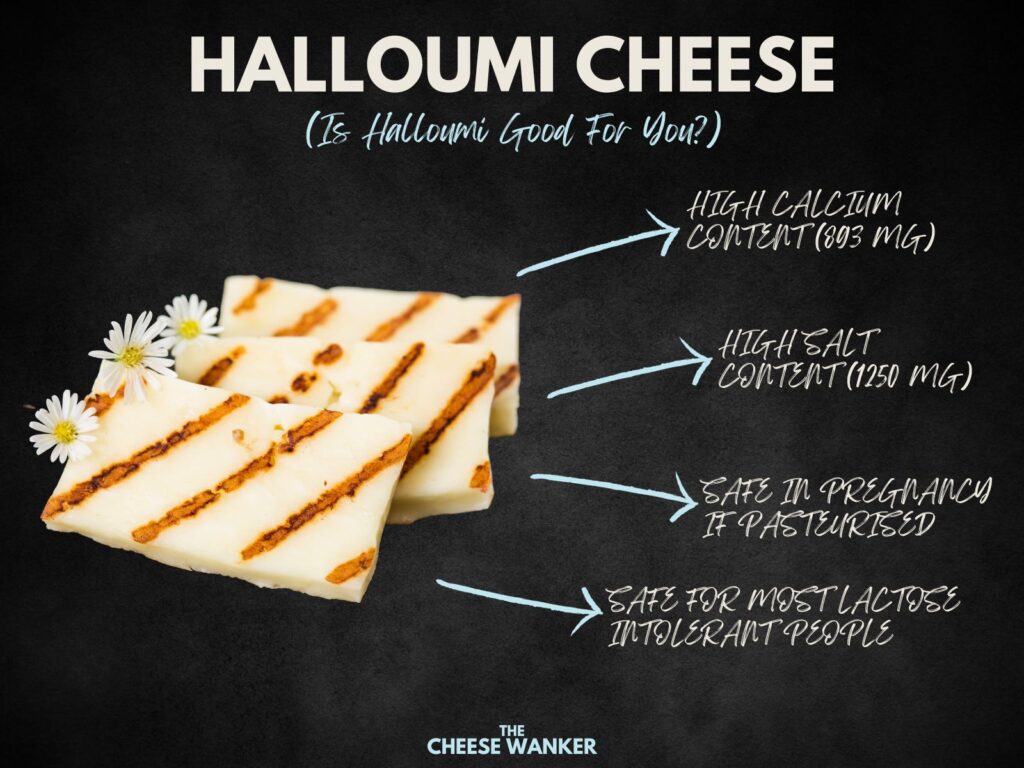
SEE ALSO: Nutrition facts for popular world cheeses in The Cheese Wanker’s index →
What is Halloumi?
Originating from the sun-kissed lands of Cyprus, Halloumi cheese stands as a testament to the rich culinary heritage of the Mediterranean region. Believed to have been crafted by the ancient Greeks and Romans, this semi-hard, unripened cheese has transcended time and borders, becoming a beloved delicacy across the globe.
What sets Halloumi apart is its unique preparation; a blend of goat’s and sheep’s milk, sometimes infused with cow’s milk, is heated and curdled, then shaped into distinctive blocks before being brined. The cheese is then traditionally stored in its own salty whey, which not only preserves its freshness but also imparts a distinctive taste.
In the realm of gastronomy, Halloumi’s versatility knows no bounds. Its robust structure allows it to hold up well under heat, making it a star ingredient in salads, sandwiches and kebabs. Alternatively, it can be enjoyed on its own, paired with a drizzle of honey or a sprinkle of fresh herbs.
Nutrition fact sheet
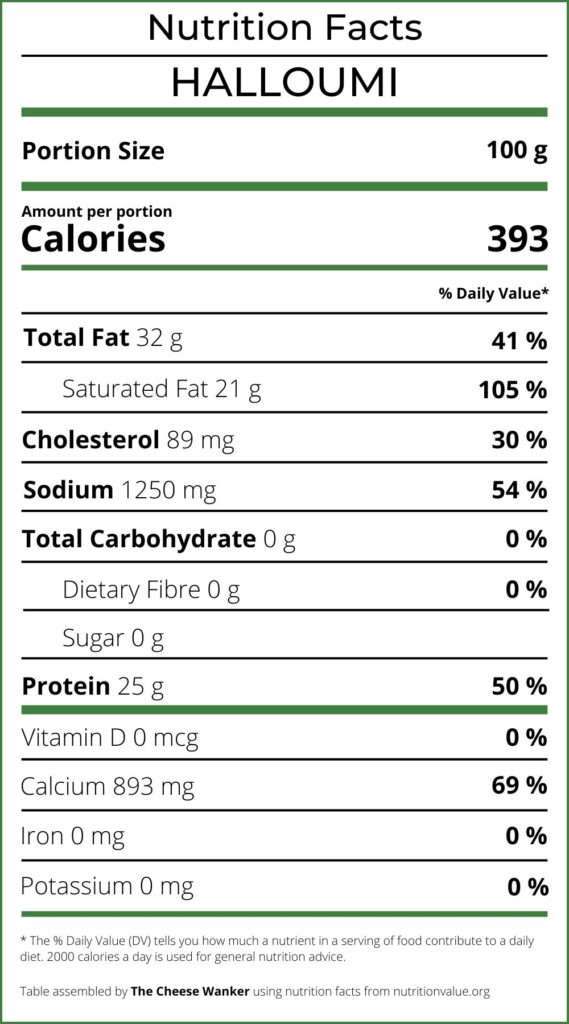
Nutritional review for Halloumi
Eating healthy plays a pivotal role in maintaining overall well-being and preventing chronic diseases. A balanced and nutritious diet provides our bodies with essential vitamins, minerals, and macronutrients, fuelling optimal physical and cognitive function.
With this in mind, let’s have a look at some of the key nutrition facts for Halloumi.
Calorie Count
One hundred grams of Halloumi cheese has a calorie count of 393, making it a calorie-dense food choice. However, when evaluating the nutritional value of this cheese, the quality of calories takes precedence over quantity.
Indeed, Halloumi provides high-quality calories, primarily sourced from proteins and fats. These nutrient-dense calories contribute significantly to energy levels, making Halloumi an excellent choice for individuals seeking sustained energy throughout the day.
Fat Content
Halloumi cheese contains 32 g of fat per 100 g serving, primarily composed of saturated and monounsaturated fats. Saturated fats, while often demonised, are an essential component of a balanced diet when consumed in moderation.
They play a crucial role in hormone production and cellular function. Monounsaturated fats, found abundantly in olive oil and avocados, are known for their heart-healthy benefits. As a result, Halloumi is a favourable choice for those mindful of their cardiovascular health.
You can learn more about the different types of fat in cheese and which cheeses have the lowest fat content here.
Protein Content
Containing on average 25 g of protein per 100 gram, Halloumi stands out as a protein powerhouse. The protein in Halloumi is of high biological value, containing all essential amino acids necessary for various bodily functions.
Protein is vital for muscle repair and growth, immune function, and enzyme production. Including protein-rich foods like Halloumi in your diet aids in maintaining overall health and wellbeing.
Want to find out which cheeses have the highest protein content? Click here for our blog post covering cheeses with the highest protein content.
Cholesterol Content
Halloumi contains 89 milligrams of cholesterol per 100-gram serving. Contrary to popular belief, dietary cholesterol does not necessarily equate to elevated blood cholesterol levels.
Indeed, for most people, consuming cholesterol-rich foods in moderation does not significantly impact their cardiovascular health. However, individuals with specific health conditions may need to monitor their dietary cholesterol intake under medical supervision.
You can learn more about the impact of dietary cholesterol on blood cholesterol levels in our dedicated post here.
Salt Content
With a salt content of 1250 milligrams, Halloumi cheese is renowned for its salty flavour. While salt enhances the taste of various dishes, excessive salt consumption can lead to health issues, such as hypertension.
Hence, it is crucial to moderate salt intake, particularly for individuals with hypertension, kidney problems or heart conditions.
You can read more about why salt is important in cheesemaking in our comprehensive post here.
Calcium Content
With about 890 milligrams of calcium per 100 grams, Halloumi is a valuable source of this essential mineral. Calcium is vital for maintaining strong bones and teeth, supporting muscle function, and facilitating nerve transmission.
For individuals who are lactose intolerant (more on that later) or have limited access to dairy products, Halloumi cheese offers a convenient and delicious way to meet their calcium needs.
Get our complete guide to calcium content in cheese in this post here.
Safety in Pregnancy
When it comes to Halloumi cheese, understanding its safety during pregnancy is paramount.
Halloumi made from pasteurised milk stands as a beacon of safety for expectant mothers. Pasteurisation involves heating the milk to eliminate harmful bacteria without compromising its nutritional value. This process ensures that the cheese is free from potential contaminants.
However, for those who prefer the unique taste of raw milk Halloumi, there is no need to fret. Indeed, raw milk Halloumi can still be enjoyed safely during pregnancy with a simple culinary precaution.
Cooking or grilling the cheese thoroughly is the key to making it safe for consumption. High temperatures effectively kill any harmful bacteria that might be present, ensuring that the raw milk Halloumi transforms into a delectable and risk-free delicacy.
By taking this additional step, expectant mothers can relish the distinctive flavour of Halloumi while safeguarding their health and the health of their baby.
Of course, if you’re unsure of what you can eat during pregnancy, you should consult your healthcare professional to get a personalised plan. You can read more about which cheeses you can eat when you’re pregnant by clicking here.
Lactose Intolerance
Finally, Halloumi is a generally well-tolerated option for individuals with lactose intolerance. Due to its low lactose content, most people with lactose intolerance can enjoy Halloumi without experiencing adverse digestive effects.
The cheesemaking process removes a significant portion of lactose, making it easier on the digestive system for those who struggle with lactose intolerance.
However, it is important to note that individual tolerance levels may vary. Some individuals with lactose intolerance may still experience discomfort when consuming Halloumi or any dairy product.
Therefore, it’s advisable for those with lactose intolerance to monitor their body’s response and consume Halloumi in moderation.
Conclusion
In conclusion, Halloumi cheese stands as a testament to the delectable intersection of taste and nutrition. Its rich protein content, quality fats, ample calcium and low lactose levels make it a versatile choice for a wide range of dietary preferences.
By understanding the scientific nuances of Halloumi cheese, individuals can make informed choices, embracing this culinary delight as a part of a balanced and wholesome diet.
As with any food, moderation is key, ensuring that the delightful indulgence in Halloumi cheese aligns harmoniously with overall health and wellness goals.
References
Overall nutritional content
The nutritional content of cheese in our table comes from the USDA Food Data Central Repository, the Australian Food Composition Database and cheese manufacturers. We realise that there can be variations between different brands and producers. Hence, the numbers we have used are averages.
Fat content
Our fat RDI data comes from Cleveland Clinic’s Healthy Fat Intake resource.
Type of fat in cheese as per Harvard T.H. Chan’s The Nutrition Source.
Protein content
Our protein RDI data comes from Harvard Medical School’s Harvard Health Publishing.
Cholesterol content
Is There a Correlation between Dietary and Blood Cholesterol? Evidence from Epidemiological Data and Clinical Interventions? – Maria Luz Fernandez and Ana Gabriela Murillo
Saturated fat, carbohydrate, and cardiovascular disease – Patty W Siri-Tarino, Qi Sun, Frank B Hu and Ronald M Krauss
Effect of cheese consumption on blood lipids: a systematic review and meta-analysis of randomized controlled trials – Janette de Goede, Johanna M Geleijnse, Eric L Ding, Sabita S Soedamah-Muthu
Safety in pregnancy
All the advice relating to what cheeses you can eat during pregnancy in this article is based on the recommendations by health authorities in Australia, the UK and the USA. If you are unsure about what you can or cannot eat, please consult your doctor.
Australia – FSANZ, United Kingdom – NHS and United Sates of America – FDA
Lactose content
Lactose residual content in PDO cheeses
Detection of lactose in products with low lactose content
The analysis of lactose in milk and cheese products by HPLC
Food Standards ANZ Food Composition Database
Lactose & Galactose content of cheese
